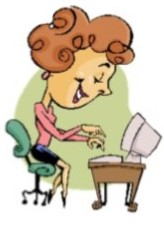|
|
|
Main Page | Getting Started | Intermediate Genealogy | Advanced Genealogy | Tools of the Trade | Crafts & Activities |
|
|
|
Main Page | Getting Started | Intermediate Genealogy | Advanced Genealogy | Tools of the Trade | Crafts & Activities |
 |
Ask A Genealogist
|
|
Are you stumped and need help? Kellie Scott, of Ancestor's Soup (a genealogical research service) will assist you with your genealogical questions. You can contact Kellie by email at kelliescott@bellsouth.net Please include KY-Kids in the subject line. |
A Head Hunting We Will Go!
By Kellie Scott
If you are the family genealogist, then you are what are known as the official headhunter of the family. One trip you will need to make is to the cemetery. Never go alone to a cemetery by yourself whether it is public or private. Always have an adult with you!
Here is a checklist of things you will need to take with you. In fact, now is the time for you to assemble your official cemetery kit!
- a cell phone if you are in a remote area
- a camera and as you take pictures, take notes on what is written on headstone
- notepad and clipboard
- if summer, donít forget your insect repellant
- first aid kit
- water and old rags, just in case you have to clean a headstone. NEVER use any chemicals on the old headstones, it will
destroy them.
- Gardening tools, just in case you have to trim weeds or grass from headstone
- Old sock filled with cornstarch
If you decide to do a rubbing of an unreadable headstone, there are certain rules you must follow. Only clean headstones that are stable in the ground. If the headstone is wobbly or the surface is crumbling do not touch it. Take a picture instead! Try to clean stone with plain water and old rags first. You may use a very soft bristle brush such as nylon on the headstone. Rinse well and dry off the headstone. Now take that old sock and beat the headstone with it. The letters should be readable now. Be sure and write this information down on a piece of paper. Before you leave the cemetery if possible do a few other headstones surrounding your relative. In the olden days, families were buried together so you may have more than one family member in a cemetery. As you are leaving, make sure you donít leave any trash.
By Kellie Scott
So you have talked to Grandma and she has told you all she knows but suggests you need to talk to your Great Aunt Susan. The problem is Aunt Susan lives in Kansas and that is long distance. Plus, you are not real thrilled about calling someone you donít even know on the phone and asking a lot of questions. So what do you do? You do things the old fashioned way, you sit down and write a letter.
If Aunt Susan does not know you, then you need to introduce yourself. Start with your name and who your parents are and the names of your grandparents. Explain that you are very interested in your family history. Write down specific questions that you think she may be able to answer. Do not write pages and pages of questions in this first letter. Just write a few and if Aunt Susan is interested she will write you back and will continue the correspondence. Sometimes elderly people are on a tight budget or confined at home, so please send a self-addressed stamped envelope for their convenience. At the end of the letter donít forget to thank the person for taking time to read the letter.
By Kellie Scott
I know you are thinking, what the heck does that mean? Most of us know what are basic family relationships are like our parents, grandparents, brothers and sisters but what about relationships like your grandmotherís nieces and nephews? Here are some tips to help you figure out just how you are related to your extended family.
COUSIN-Your first cousins are the children who have the same grandparents as you, in other words, the children of your aunts and uncles.
SECOND COUSIN-These are the people who have the same great-grandparents as you.
REMOVED- A cousin removed means you are cousins but from two different generations. You and your first cousins are from the same generation so the word removed is not used. The words ďonce removedĒ means there is a difference of one generation. For example: Your motherís first cousin is your first cousin, once removed. This is because your motherís first cousin is one generation younger than your grandparents and you are two generations younger than your grandparents. Twice removed means there is a two generation difference.
Now that you have a basic idea of what these different words mean, take a look at the cousin calculator and figure out how the different people in your family are related. Cousin Calculator
Main Page | Getting Started | Intermediate Genealogy | Advanced Genealogy | Tools of the Trade | Crafts & Activities |
||
|
Copyright © 2005-2008 KY-Kids KyGenWeb Coordinator Mrs. Jerry Taylor
Permission is granted to save this image to use as a link on family friendly websites.
|
||
|
|
||